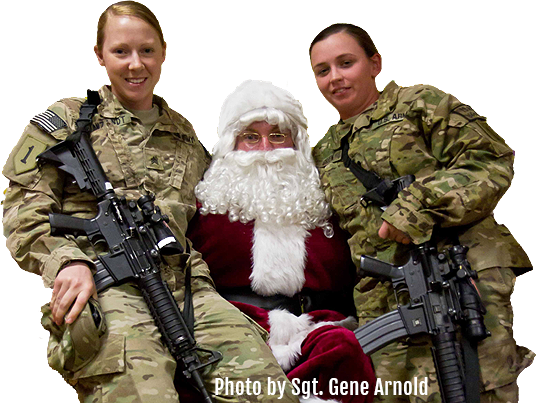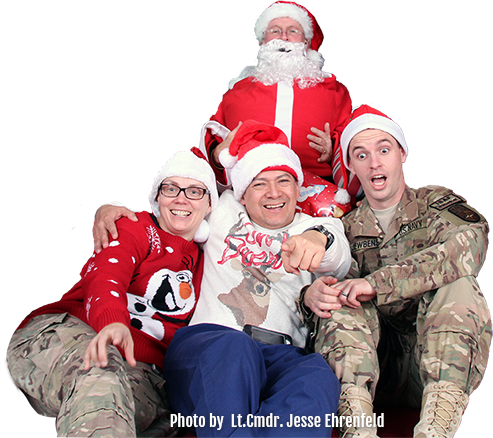[caption id="attachment_3364" align="alignleft" width="311"] Air Force Master Sgt. Justin Jordan takes a break with Dallas, his 2-year-old female English bulldog. Dallas is a service dog trained to help Jordan recover from post-traumatic stress disorder. U.S. Air Force photo[/caption] KIRTLAND AIR FORCE BASE, N.M. – Arriving home after deploying to a war zone can bring new challenges to military members. Many discover that their fight is not over. They end up facing an unseen enemy, with sometimes serious consequences. That enemy is post-traumatic stress disorder.
Air Force Master Sgt. Justin Jordan takes a break with Dallas, his 2-year-old female English bulldog. Dallas is a service dog trained to help Jordan recover from post-traumatic stress disorder. U.S. Air Force photo[/caption] KIRTLAND AIR FORCE BASE, N.M. – Arriving home after deploying to a war zone can bring new challenges to military members. Many discover that their fight is not over. They end up facing an unseen enemy, with sometimes serious consequences. That enemy is post-traumatic stress disorder.
 Air Force Master Sgt. Justin Jordan takes a break with Dallas, his 2-year-old female English bulldog. Dallas is a service dog trained to help Jordan recover from post-traumatic stress disorder. U.S. Air Force photo[/caption] KIRTLAND AIR FORCE BASE, N.M. – Arriving home after deploying to a war zone can bring new challenges to military members. Many discover that their fight is not over. They end up facing an unseen enemy, with sometimes serious consequences. That enemy is post-traumatic stress disorder.
Air Force Master Sgt. Justin Jordan takes a break with Dallas, his 2-year-old female English bulldog. Dallas is a service dog trained to help Jordan recover from post-traumatic stress disorder. U.S. Air Force photo[/caption] KIRTLAND AIR FORCE BASE, N.M. – Arriving home after deploying to a war zone can bring new challenges to military members. Many discover that their fight is not over. They end up facing an unseen enemy, with sometimes serious consequences. That enemy is post-traumatic stress disorder.PTSD is an anxiety disorder that can affect people who have experienced extremely stressful and traumatic events, such as witnessing the loss of human life or as being a victim of a violent attack.Air Force Master Sgt. Justin Jordan, the Air Force support integration superintendent with the Air Force Inspection Agency here, lives with PTSD. The 17-year Air Force veteran has served numerous overseas deployments and assignments with mortuary affairs. "Constantly dealing with death, dismay and putting soldiers in the ground at record pace is what led me to having PTSD," Jordan said. "Your brain is just not equipped to take that all the time." Those closest to Johnson couldn't tell he was dealing with PTSD, because the signs are not always obvious. "People who worked around me had no idea that I had these issues," he said. "I could be totally freaking out and holding a conversation with them at the same time." His symptoms, he said, include zoning out for hours at a time, flashbacks to stressful events, fear of crowds, avoidance and constant worry. "There were times when I would drive 20 [mph] down the highway because I was positively certain that a tire would pop." His family was affected by his condition as well. "My children suffered, for there were times when I didn't let them go outside to play because I was so worried that something was going to happen," Jordan said. All of these things led his friends and family to tell him something was wrong and he needed help. While attending an event on base with his daughter, Jordan met Jim and Lindsey Stanek, founders of a nonprofit organization called "Paws and Stripes." The organization trains and provides service dogs at no cost for veterans dealing with PTSD and other mental and cognitive disabilities. Jordan said talking with the Staneks gave him hope that this could be exactly what he needed, and after extensive research and consulting with his doctor, he decided to enroll in the program. Paws and Stripes trains dogs to be constant companions of their owners, so wherever the owner goes, the dog goes. Because they are service dogs, in the same category as seeing-eye dogs for the blind, business establishments and airlines must, by law, admit them. Though Paws and Stripes provides veterans with service dogs, Jordan elected to have the organization train a dog he already had, a 2-year-old female English bulldog named "Dallas." Having a canine companion in the workplace is an important part of the therapy that the dogs provide. Because leaving the dog at home would be the equivalent of not taking daily medication, Jordan sought and received approval from his chain of command to bring Dallas to work. "I got a lot of support all the way from chiefs to colonels, who told me that they knew exactly what I was going through," he said. Jordan said taking Dallas to work every day mitigates the effects of PTSD. She has an area next to his desk, and to keep him from zoning out, she is trained to tug on his sleeve several times an hour as well as pace back and forth catch his attention. In the same way that dogs are trained to detect seizures before they occur, "Dallas is being trained to detect if I'm about to have an issue, and if so, she'll do something to distract me," Jordan said. Dallas also is trained to watch Jordan's back. When his back is turned to a door, she is trained to face the door so she will be able to alert him if anyone comes in. Also, if Jordan is in a line, Dallas will position herself behind him to give him space and prevent others from getting too close. All of this is done in a nonaggressive matter. She does not bark, bite or threaten people in any way. Having a dog at work can create challenges, because Dallas is on a leash with Jordan at all times. If someone in the office needs assistance lifting or moving something, Jordan ties Dallas' leash to his belt and then helps out. "I don't want to be treated 'special,'" Jordan said. "I have a dog and she helps me, just like someone with a wheelchair. I don't want anyone saying that because I have a dog I can't do something. Whatever it is that I have to do, me and Dallas will make it happen." Jordan sometimes faces odd stares and sometimes is stopped by people wanting to know why he has a dog in the building. He turns these challenges into opportunities to talk about PTSD and organizations like Paws and Stripes that help veterans assimilate into society. "I've suffered a lot of guilt," Jordan said. "But I'm old enough now to know if you need help, get it. Dallas provides that help. She's got my ‘6’ every day." Oct. 4, 2010: By Brian Brackens- 377th Air Base Wing






